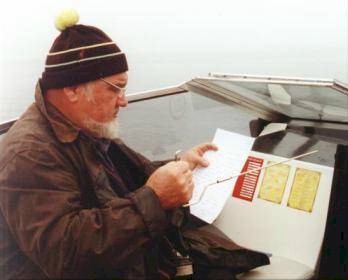
Our resident dowser, Derek Yates, has always intrigued me with his site
prospecting techniques, walking across the fields with copper rods in hand. I must
admit, in the past, I have been a little sceptical. However my scepticism has taken
a real knock recently with the discovery of a 350 year-old sunken ship by dowsing.
The Blessing of Burntisland was found by Jim Longton, who pinpointed the wreck with a map
dowser one mile away from the Fife town. He identified the co-ordinates on an
Admiralty map and later chose exactly the same spot while using a dowsing rod on the
river.
King’s Wreck
The Burntisland sank during King Charles I’s coronation tour of Scotland and was
known to be carrying gifts from Scotland noble families. He had travelled from the
royal hunting palace at Falkland, reportedly with his possessions loaded on 200 carts
drawn by 1,000 horses trying to make the crossing of the Forth. The treasure was estimated
to be worth £100,000, one sixth of the entire Scottish Exchequer. Among the items
lost was a priceless 280-piece silver dinner service commissioned by Henry VIII. The
Ferry sank on July 10th 1633 with the loss of 35 servants and crew. Only two survived.
The Search
If this find is the Burntisland, it ends an eight-year search and archaeologists
confident a lot of it, perhaps even the treasure, has survived in the silt. The
Project team, who now call themselves the Burntisland Heritage Trust, have used over the
years a variety of prospecting tools including magnetometers, side-scan sonar, a
sub-bottom profiler and a secret imaging and analysis system, (which they don’t want
to talk about). Objects found in the Forth include an armed naval tug-boat from
World War I, and a "Hurricane" fighter plane from World War II. It was
only when Jim Longton got involved however that they were able to home in on a particular
anomaly that turned out to be that of a large wooden vessel, whose dimensions correspond
to those of King Charles’ baggage ship. Limited diving on the site has corroborated
the remote evidence, despite the poor visibility and fierce tides.
Further Work
The wreck has also been made the subject of a preservation order by the Scottish
Secretary to allow for further investigations. The Archaeological Diving Unit, based at St
Andrews University will be able to take samples from the wreck for dendrochronology (tree
ring dating) and also in the summer, conduct a physical fixed-point survey, additional
sub-bottom sonar work as well as analysis of the surrounding sedimentation. If you
want to know more about the project their web site is www.kingcharles-wrex.co.uk which is possible
to subscribe to, to keep updated with the latest news.
Next Meeting
(Wednesday 3rd March at the history shop at 7.30 pm as usual.) This month’s
speaker is Brian Marshall, who will be giving us a talk on ‘The Historic &
Prehistoric Treasures of Ireland’. Brian is an old favourite who has given us
talks before on ‘Prehistoric Malta’ and ‘The Cathards of Southern
France’.
Hope to see you at the meeting - B.A.
|



